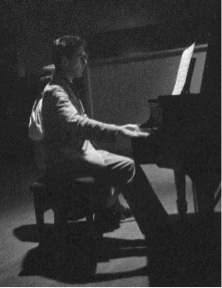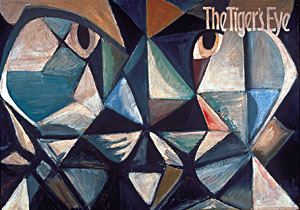
[This is part of the series Opening the door into emptiness]
In “A composer’s confessions”, Cage described his search for meaning as a composer, his study of Asian and medieval philosophy and mysticism, and the conflict he found between the traditional spiritual practice of music and the ego-driven practice of his own experience. Shortly after this, he presented his first attempt at defining his own philosophical framework for music: “Defense of Satie”, a lecture given at Black Mountain College in the summer of 1948. The lecture was an accompaniment to Cage’s presentation of a festival of Satie’s music, and sought to establish a basis for taking Satie’s work seriously. In it, he presents a systematic philosophy of music, largely designed to validate his position that musical structure should be based on lengths of time.
But while publicly the lecture was about Satie, personally it was Cage’s attempt to build a framework for music that could integrate what he needed in his life from both traditional and avant-garde music. In the opening of the lecture Cage describes the conflicting needs for both “art which is not private in character but is characteristic of a group of people,” and for art that displays originality, innovation, and independence. He sets forth his purpose as the reconciliation of these conflicting needs:
Now I would like to ask and answer the questions: What kinds of things in art (music in particular) can be agreed upon? and What kinds of things can be not agreed upon? For I suspect that our admiring two opposite positions, that of the traditional artist and that of the individualist, indicates a basic need in us for this pair of opposites. We need, I imagine, an art that is paradoxical in that it reflects both unanimity of thought and originality of thought.
Cage defines four elements of music: Structure, Form, Material, and Method. Structure is the division of the whole into parts. Cage defines Form as “the morphological line of the sound-continuity.” This is close to the common distinction between structure and content, although Cage’s emphasis is a bit more on the dynamic, moment-to-moment aspect of content. By Material, Cage means actual sounds, and he defines Method as the means by which one strings these sounds into a continuity. Ideas about these last two elements are less developed in the lecture.
After presenting these four elements, Cage then asks the question about which of these can be agreed upon and which cannot: in other words, which elements should be the same across all music, and which should be unique to a particular composer. Cage sees Structure as the element of music that absolutely must be agreed upon: he states that all structure should be based on lengths of time. He sees Form just as unequivocally as the element of music that must remain completely personal. He has no strong opinions about the other elements (Material and Method) and suggests that it is “a matter of indifference” whether or not composers agree in their treatments of these.
Cage makes the argument for musical structure based on lengths of time by stating that time is the only thing common to both sound and silence. This is a new idea for Cage: when he explained rhythmic structures in “A composer’s confessions” he gave other reasons for its use. Citing a physical fact of sound as the basis for all musical structure serves to justify his own work, but it also suggests a common practice that could fill the role of tradition in the kind of healthy spiritual culture described in Coomaraswamy’s writings. Commonality of structure would open up the possibility of an art that goes beyond the merely personal.
“Defense of Satie” is quite different in tone to “A composer’s confessions”, more self-assured and polemical. It is also more technically oriented, lacking for the most part the spiritual dimension. Cage acknowledges something like this only at the very end of the lecture. He summarizes the four elements of music as either “Law elements” (primarily Structure) or “Freedom elements” (primarily Form). He then presents the purpose of music as the integration these opposing elements, an allusion again to Jung’s idea of the integration of the personality. “Good music can act as a guide to good living,” he says, a means of obtaining “peace of mind, self-knowledge.”
Cage had not abandoned his spiritual quest, however. A few months later, he wrote an essay for the art and literature magazine The tiger’s eye in which he covers the same ground, but with a much greater emphasis on the spiritual dimension. “Forerunners of modern music” is an exposition of the same basic tenets expounded in “Defense of Satie”: Structure must be agreed upon, while Form “wants only freedom to be”; Structure should be based on time-lengths, and music should turn away from the decadence of harmonic structure. But the language used to describe this is dramatically different. There are many uses of overtly spiritual language, largely drawn from the sermons of Meister Eckhart. Cage sets the tone in the very first paragraph:
Music is edifying, for from time to time it sets the soul in operation. The soul is the gatherer-together of the disparate elements (Meister Eckhart), and its work fills one with peace and love.
Of particular importance in “Forerunners” is the way that Cage describes the four elements of music. He drops the terms “Law elements” and “Freedom elements” and instead associates the elements of music with “Mind” and “Heart”. The article includes a diagram showing structure on the Mind side and Form on the Heart side, with Method and Material falling in the middle, influenced by either Mind or Heart.
The diagram includes another way to express the duality: “consciously controlled” elements versus elements “unconsciously allowed to be.” The Mind/Heart, Conscious/Unconscious dualities come from Cage’s reading of spiritual texts and Carl Jung. These represent a subtle shift in Cage’s handling of the idea of “Law elements” in general and Structure in particular. In “Defense of Satie” Law elements simply meant those elements that should be agreed upon to form the common ground for musical practice. In “Forerunners”, Cage associates Law with control, specifically the conscious control of the Mind. The implication here is that any element of music that falls on the Law/Mind side of the duality is subject to thought-out systematic control (both Structure and Mind, Cage says, “delight … in the observance of rules”).
Cage describes the systematic, Mind-controlled approach of Structure as a way of purifying the composer from an overly strong sense of self. He uses the terms “structural elements” and “formal elements” as synonyms for the Law/Freedom duality, and associates the discipline of Structure with Meister Eckhart’s notion of a pure soul:
Imitating either oneself or others, care should be taken to imitate structure, not form (also structural materials and structural methods, not formal materials and formal methods), disciplines, not dreams; thus one remains “innocent and free to receive anew with each Now-moment a heavenly gift” (Eckhart)
In “Forerunners of modern music” Cage’s initial unfocused ideas about how to connect his music to something larger than his own self begin to coalesce around the selfless, empty nature of systematic procedures such as his duration structures. Cage concludes with an explicit statement of music as a path to transcendent experiences:
The in-the-heart path of music leads now to self-knowledge through self-denial, and its in-the-world path leads likewise to selflessness. The heights that now are reached by single individuals at special moments may soon be densely populated.
“Self-knowledge through self-denial” is the new direction that Cage’s work and thought were taking. In “Defense of Satie,” Cage had presented the Law of Structure and the Freedom of Form, but he had made no connection between the two. In “Forerunners”, Cage presents freedom as resulting from the abandonment of self via mental disciplines: “If the mind is disciplined, the heart tuns quickly from fear towards love.”
Read the next post in this series: 5 — Praising silence
Sources & asides
“Defense of Satie” is published in John Cage, Kostelanetz, ed. (New York: Praeger Publishers, 1970), pp. 77-84. “Forerunners of modern music” appears in Silence (Middletown: Wesleyan University Press, 1961), pp. 62-66. The diagram appeared only in the original Tiger’s Eye version. It is reproduced here from The Boulez-Cage correspondence, Nattiez, ed (Cambridge: Cambridge University Press, 1993), p. 39.
Cage’s quotations from Meister Eckhart are from the Raymond Blakney translation (New York: Harper & Row, 1941). This is interesting in that, when asked in 1960, he cited “the early two-volume translation” (by C. de B. Evans) as the one that influenced him, not the Blakney (“List No. 2”, in John Cage, p. 139).
The cover of The Tiger’s Eye shown here may or may not be the cover of the issue in which Cage’s article appeared.


